When she was a child, Megan commandeered scrap paper and markers to create family “newspapers.” She learned to read at age 3 by reading out loud from the T.V. Guide. When a relative wasn’t convinced, she was handed pages from the New York Times to read. Her family is still trying to figure out where she gets her writing ability from.
Megan is a 2002 graduate of the University of Alabama, where she was a member of the Million Dollar Band and served on staff at the Crimson White. Upon graduation, she embarked on a newspaper career that took her from Alabama to the border of Tennessee and Virginia, up to Maine, across the country to Arizona and back east to Pennsylvania.
Megan is a journalist for PennLive.com/The Patriot-News, where she is a data reporter, podcast producer, and social media manager. She lives in (the real) Mechanicsburg, Pennsylvania, with her imported British husband, her cats and many books – and has yet to find any malicious clanks lurking in her house.

Isabelle Melançon is a French-Canadian artist born in 1985. She grew up in a family of book and comic-lovers. She reads manga, European comics and American comics and has been drawing ever since she could lift a pencil. She used to want to be a dragon-riding knight, then envisioned a career change as a fantasy writer at the age of 10.
Since then, Isabelle has been drawing her way through school, which included doodling on lockers, and graduated from the University of Ottawa with a visual arts and administration double-major. Isabelle has a few published graphic novels and art exhibits under her belt. Namesake is her first long-term project.
Isabelle’s drawing style is heavily influenced by American and Japanese animation, as well as older Victorian and French illustration work, creating a fluid yet detailed mix.

She is madly in love with fairy tales and literature and enjoys playing with the classics in her comic and written works.
I had the opportunity to interview both Isa and Meg, which you can read below.
First of all, welcome to Geeks OUT! Could you tell us a little about yourselves?
Isa: I’m Isabelle, I have been working on the webcomic Namesake for over a decade with Megan! We both take care of the writing, and do the art. I also work on other webcomic projects such as the comedy webcomic Crow Time, and an upcoming comic called Trinket, which is a magical girl story, with artist Inês Bravo. I work as an editor and in artist management, mainly at the webcomic focused publishers Hiveworks & Slipshine. I drink a lot of tea, have two cats, and identify as bi, genderfluid and ace!
Meg: I’m Megan, and I have been working with Isa on Namesake for over a decade! Like Isa said, we both do the writing and Isa does the art. I do the lettering and book design, as well as maintain the business end of our partnership. Outside of the comics I do with Isa, I do lettering for other comics as well. I am a journalist for PennLive.com/The Patriot-News, where I handle social media, podcast producing, and data reporting. I run Hivemill, the store for Hiveworks, as well as do book design for Hiveworks. Like Isa, I also have two cats. I identify as she/her and demisexual.
How did your webcomic, Namesake, come to be? Where did the inspiration for the project come from?
Isa: I think it came from a very aspirational place. At the time, webcomics that were huge fantasy epics were starting to pop up, like Gunnerkrigg Court, The Meek and Girl Genius. Megan and I were bathed in the light of incredibly creative fandoms on the platform where we met – Livejournal. I was always drawing very loose pencil comics inspired by fandoms we liked, and scraps of adventurous ideas we both longed to see in media. At some point, Megan was like, yeah, you should be drawing this. And my reply was basically, ok, but I’m taking you with me. Essentially, it was the idea that we could make something we felt was overlooked and unique at the time, a comic serial built around women in fantasy, and we didn’t need to wait for a large publisher to notice us, we could just dive in and make our world. We were both complete newbies at making comics professionally and to the English comic community. Me, especially, since I was still mastering English as a language.
This happened, as stated above, quite a while ago. When we met stuff like Patreon and Kickstarter, tools that are now considered essential to webcomics, didn’t exist yet.
Since then, there’s been a huge boom in comics both online and offline. Print publishers are making way more graphic novels than ever before, collective publishers such as Hiveworks came to be, and platforms such as Webtoons and Tapas were introduced to the English market. I have an abundance of favorite comics and authors online now, our dream of an abundance of unique comics came true. It’s nice to see this happening, after doing Namesake for so long. We went from this mindset of “we need to do this because it doesn’t exist” to “we are part of a massive collective of (queer) creators” and that’s a unique experience.
Meg: The comic content itself came from a love of fairy tales, such as the Wizard of Oz and Alice in Wonderland. The earliest form of Namesake is a fandom parody comic that ran on Livejournal.
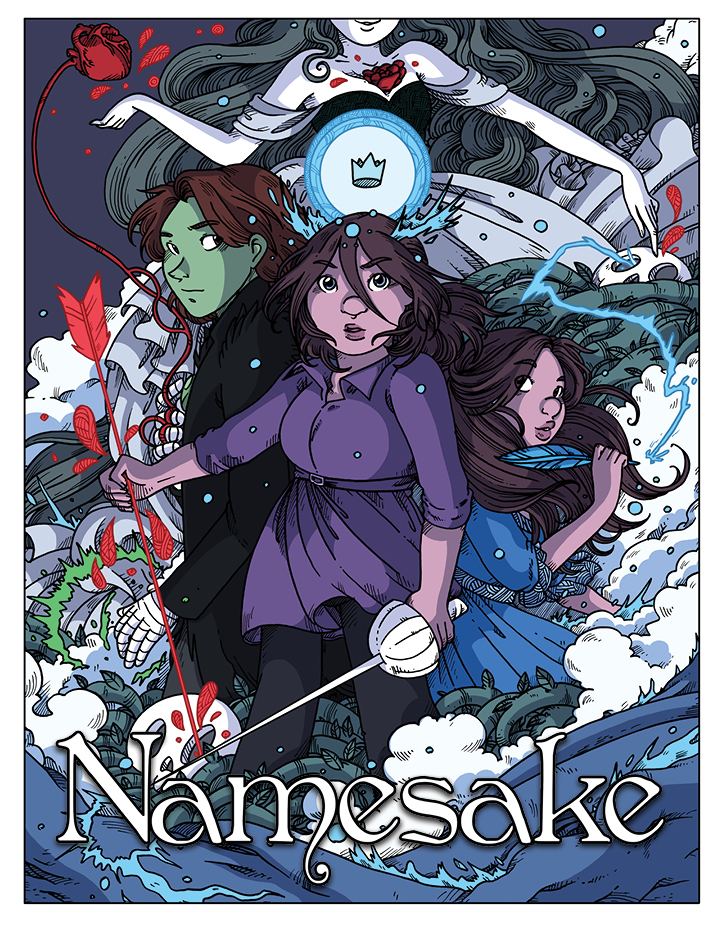
How did the two come to know each other and work together creatively? How would you describe the collaboration process?
Isa: We met in fandoms, like many people do online. Collaborating came easily. I’m very flexible by nature and Megan was already used to collaborating with people professionally, being a journalist. The flow of how we collaborate is very much a conversation and even happens in the form of a discord chat nowadays. Usually we do a chapter outline, then I pencil the comic in sequences of 4 pages, which I then share with Megan, and we discuss them!
Meg: It is an unusual process, but one that has worked well for us. One of my favorite stories about that is when we worked on the Womanthology anthology. It was the first one we did together, and we had a proper editor. We worked in our normal process of discussing pages over Isa’s sketches. And the editor wanted to see an actual script, despite us having completed sketches with dialogue. So, I wound up writing a Marvel-style script based on our sketched pages just to make the editor happy.
Isa is so great at coming up with the overall plot, and I am our details person.
Who are some of your favorite characters to draw/write?
Isa: There’s a lot of characters that are fun to draw because they are very appealing, design wise. But I think my favorite to draw right now (and write) is probably the lead, Emma. I’m just a sucker for strong hero energy. I love how she moves on a page; I love how she thinks, I love to draw her monster forms when she changes, it’s all great.
I also really like drawing animals and weird creatures right now, a lot.
Meg: I have always felt close to Elaine, and I really enjoy writing for her. I also really, really love writing for Jack. His sense of humor and optimism is fantastic, and my favorite romance in the series is actually the one between Jack and Penta. I also enjoy writing Warrick in peak snarky mode, as well as Agha and Hercilia from the Oz arc. We’ll be seeing those two again soon, which is great, because I really love writing those two.
Considering Namesake is based on several fairytales and classic children’s book stories, what would you say are some of your personal favorites?
Isa: My all-time favorites are Cinderella, Beauty and the Beast, the Little Mermaid, Diamonds and Toads, and Prunella, to toss an obscure one in. I plan to tackle all of these in individual comics one day. I do think Cinderella is my number one because it’s so simple, efficient, and emotional. There are versions of Cinderella in every country dating far back. For as long as we’ve had jerks and classes, we’ve had Cinderella stories.
Meg: My favorite fairy tale is Thumbelina, and I was thrilled when we got to visit her world in Namesake. I have always enjoyed stories of little people wandering around a larger human world, like Thumbelina and the Borrowers. I blame watching way too much of the Smurfs when I was a child! My other favorite fairy tales are The Wild Swans, Momotaro from Japan, The Red Shoes, and The Emperor’s New Clothes. Lots of Andersen in there, because that’s what I grew up reading. My mom passed down her copy of Andersen’s fairy tales to me.
As an artist/ writer, who or what would you say are some of your greatest creative influences and sources of inspiration?
Isa: There are a few comics I always re-read when I feel stuck. Namely, the manga Gunnm (translated and adapted into Battle Angel Alita for USA audiences), the 70’s comic Elfquest, Sandman, the works of Clamp and Rumiko Takashi as a whole, Full Metal Alchemist, Berserk, Please save my Earth, and Sailor Moon. I don’t think they’ve all aged gracefully, but they still bring me a lot, emotionally, as inspirations. The Italian comic Sky Doll had a big influence on how I draw when I discovered it as a young artist, as does the work of webcomic artists Petra Erika Nordlund and Emily Carroll.
I’m focusing my response on what inspires me when I’m feeling stuck because, I’ll be honest, my inspiration list is long and updated daily with new favorites. I consume comics and novels obsessively. Right now, in the newbie category, Ascendance of a Bookworm is a big one, as well as the webcomic Obelisk and the Korean webtoon I Dream of Health, Wealth, and a Long Life. The manga series Kusuriya no Hitorigoto and Sousou no Frieren currently live on my desk and the recently printed webcomic Hooky book two is something I’m excitedly waiting for. I’m probably as much of a comic reader as I am a creator.
Meg: My love of history directly comes from being given a set of Laura Ingalls Wilder’s Little House series when I was a child. I was heavily influenced regarding storytelling structures by J. Michael Straczynski’s Babylon 5, and I still love re-watching this series. I find something new to appreciate, even 25 years after I first watched it. My biggest influence in writing dialogue is the In Death mystery series by J.D. Robb. I love the huge cast of still-growing characters and the banter they have with each other.
Rumiko Takahashi was the first manga artist I read, and her work got me into comics as a whole. If I need inspiration for writing, I actually turn to my favorite romance novel writers these days. Tessa Dare, Lisa Kleypas, Cat Sebastian, Courtney Milan and Eva Leigh all write lovely, witty dialogue.

Why did you find yourself exploring/reconstructing the specific stories you do and why do you think as writers and readers we keep getting drawn to fairytales when making new stories?
Isa: Fairy tales are the building blocks of story and symbolism. Fairy tales and folk tales are an international story type that has existed forever. It’s so much the building blocks of story that the Aarne-Thompson-Uther Classification of Folk Tales exists. If you don’t know what that is, it’s basically an ancient TV tropes composed by Finnish folklorists.
Fairy tales have a rich imagery and a power that is undeniable. People have built media empires on the back of fairy tales. Peter Pan as a play has kept a children’s hospital financed for decades. Everyone remembers the illustrations of the first folklore picture book they have held. Loving fairy tales to a point where you work with them is just accepting that you’re enthralled by a fairy queen. That’s just your life now. However, I don’t think fairy tales should be used in modern stories without thinking about them critically, learning about their origin and using them in a transformative way.
There’s always this underlying idea of beauty and riches tied to goodness in fairy tales which is complete rubbish when taken as is. Andersen wrote objectively queer fairy tales, but a lot of interpretations ignore that. There’s also a bucketload of patriarchy and outdated representation in a lot of fairy tales that you must make sure to shed. Peter Dinklage recently expressed concern regarding the representation of little people in Snow White and a lot of people pushed back, seeing it as him messing with the classics. But if you have imagination, removing what is rotten in your inspiration is a fun challenge. Fairy tales are good to use, fun to research, and an amazing way to create a world that feels magical but real, because deep down we all know the fairy tale rules. But they aren’t perfect. Using them without reflection is not ideal.
Meg: I have always been a fan of the “what if?” plot? What if you took a single element and just tweaked it slightly? How does this change the universe? I really love alternate reality stories. An example of this in Namesake is right at the very beginning with Charles Dodgson and Alice Liddell. After Dodgson died, his family decided it was in their best interest to censor his diaries. So they cut a lot out, including the pages in the diary discussing the split with the Liddell family. It’s led to so much speculation. I decided it was perfect for Namesake. In our story, the cut pages deal with Alice’s first Wonderland trip.
You’ve both been working on Namesake since 2010, so over a decade now! Do you see the story coming to a close anytime soon?
Isa: We are in the final arc of the story, which is the fun adventure one. I did have to slow down production to accommodate health concerns, so we’ll probably still be at it for a while. Namesake did get called a “classic older webcomic” on tiktok so I assume that’s my cue to take however many years I need to finish.
Meg: We have been working on it for so long that it’s hard to imagine not working on it. No matter how busy I’ve gotten, working on Namesake has been a comfort to me.
Considering all the changes (both in art style and narrative) this comic has gone through since its inception, how do you feel yourselves have changed creatively or personally since then?
Isa: Well, we both grew from young adults to being in our late 30’s to 40’s, so I’d say we’ve changed a lot, across the board. Our approach to Namesake itself has not changed much – the themes we had initially are still themes we care about greatly, and the fairy tale adventure inspiration keeps the story timeless. We have gotten better at telling the story – our touch is more subtle, our approach to characters gentler. Scenes are more balanced, and our goals have oriented towards including more joy. I would say the main change is general improvements as storytellers and more happiness making our work than ever.
Meg: I agree with Isa. We especially wanted to write a healthy relationship being at the core of our center romance in the series. Really, both center romances. I know personally that I have gained a lot of self-confidence doing this series.
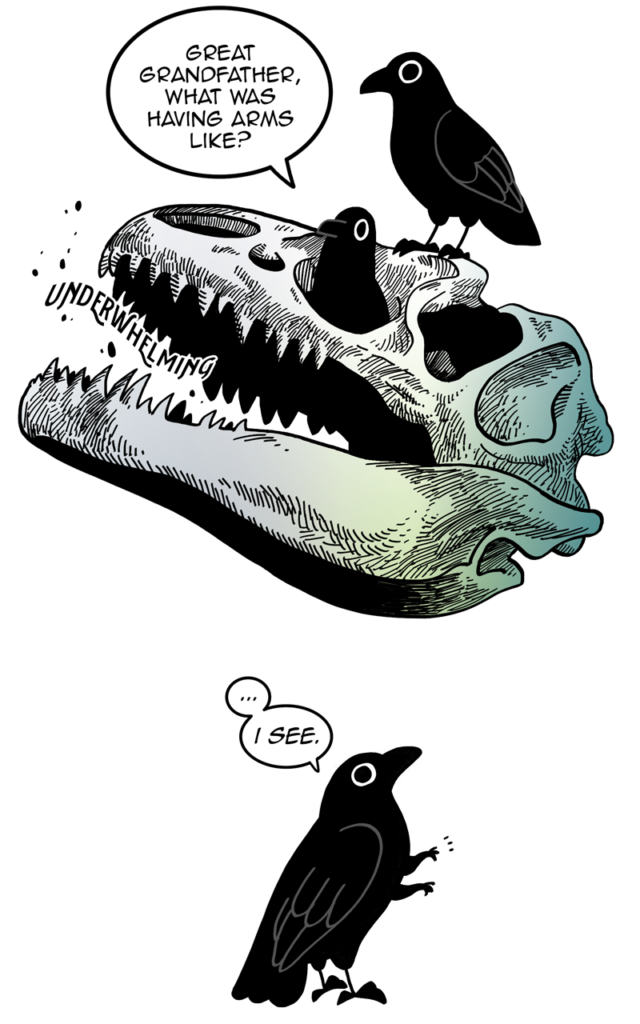
What are some of your favorite elements of the webcomic/graphic novel medium? What craft elements/techniques stand out to you the most?
Isa: I really like designing a page (and inking it). I still work traditionally so page design is fun to do. I like to think my paneling is pretty good.
Meg: I learned how to do lettering and book design when I worked as a newspaper designer, and I always loved that work. I really enjoy the process of book design and lettering panels. There is something magical about fonts and how using the right one can determine the entire mood of your work.
What’s a question you haven’t been asked yet but wish you were (and the answer to that question)?
Isa: I’m not sure! People ask me questions all the time, as an editor. I never really think about un-asked questions. I suppose I’d love there to be more discussion about working traditionally in contemporary comics. It’s getting rarer, especially with traditional paper comics adapting poorly to scroll-down comic formats. I’m not the type of person who has disdain for digital art and tools. Digital comics are gorgeous, and digital tools are very useful and I use them myself often. But I do think we are losing something important if nobody inks comics traditionally. It would be nice to have more tutorials and general attention for them. Inking challenges are a big help to that, I love those!
Meg: I love that you asked this, because I ask it myself as a journalist! I can’t really think of anything off the top of my head.
Are there any other projects you are working on or thinking about that you can discuss?
Isa: I’d just like to encourage folks to follow me on Instagram to read my short Crow Time comics, and to follow Inês for future Trinket news! We do have other comics in the works – we really want to draw an adaptation of Carmilla. But due to health issues I’m mainly focused on Namesake, Crow Time, and Trinket for now!
Meg: What she said! Right now, my main focus is supporting Isa.
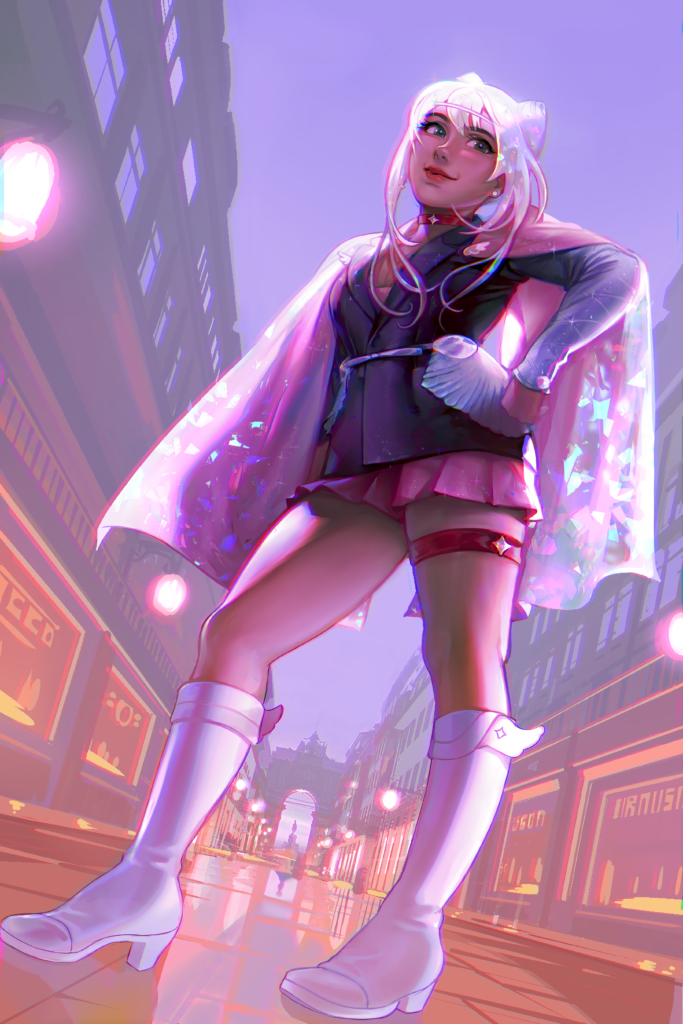
What advice would you give to other aspiring creatives?
Isa: Always take at least one day off per week, even if someone is on fire. No matter where you are in the industry; print, studio, webcomic, webtoon, successful or beginner, you’re always in a situation where it’s easy to accept overwork as part of your life, especially if it’s being pushed on you by success or deadlines. A lot of people expect that when you reach a certain level of success, you can relax. But there’s a pressure to perform that comes with success, even tiny success, and this idea that if you don’t capitalize on it fast enough, you’ll lose it. There’s never a stage where you “make it” hard enough that you can relax. There are always more deadlines and demands. Take your rest when you need it, not when you earn it. This is the hardest thing to do as an artist – I’m not even successful at it, at all. But the consequences of overwork are numerous, so even if you fail, you should always try to incorporate rest time in your work week.
Meg: Turn off any sort of anonymous commenting, whether it be on Tumblr, in the comments section of your comic, or any other social media. There are so many people trolling out there because they know they upset you. They are specifically looking for a response from you, and it rewards them when you grant it. Don’t let them get to you. Don’t be afraid to block or mute someone. Heavily curate your experience. My Twitter feed is largely romance novels, comic artists, and cats. Your mental well-being is so important. Have a safe support team that you can vent to. Don’t be afraid to get off social media entirely. It all plays into what Isa said as well about taking time off. That especially includes social media.
Finally, what LGBTQ+ books/comics would you recommend to the readers of Geeks OUT?
Isa: Ooh, Yoru to Umi is superb, I wish more people would read it! It’s only available in French, I’m afraid. The webcomic Kiss it Goodbye by Ticcy is adorable and will be in print soon as well! These are the two I’m into right now! I like cute ones!
On Hiveworks the webcomics Vainglorious, Tiger Tiger, Speak of the Devil and Obelisk have good gay energy that I love! Please also check out Brimstones and Roses on Webtoons. It has nice bi rep!
Meg: Hi, let me tell you about my immense love of Letters for Lucardo. I love that series so much, and I also love Check, Please! as well. If you like romance novels, read the works of Cat Sebastian, Casey McQuiston’s Red, White & Royal Blue, Alyssa Cole’s How to Find a Princess, and The Lady’s Guide to Celestial Mechanics by Olivia Waite. One thing that is on my to-read list is A Lady for a Duke by Alexis Hall, which features a trans heroine. I’m waiting for my copy to come in through the library!


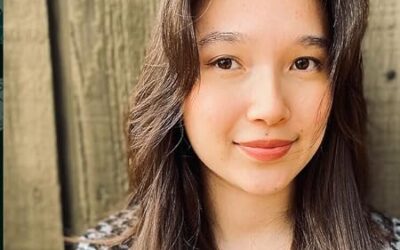
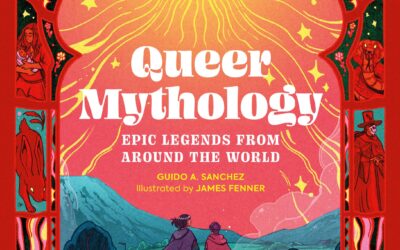

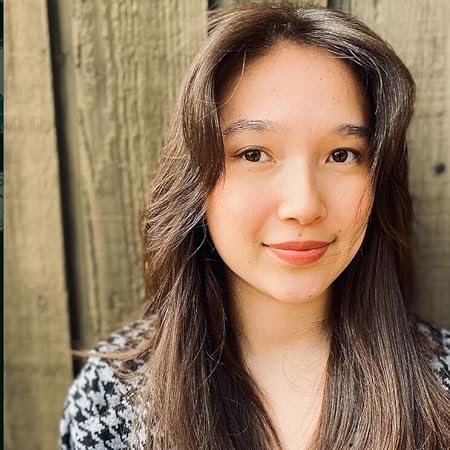
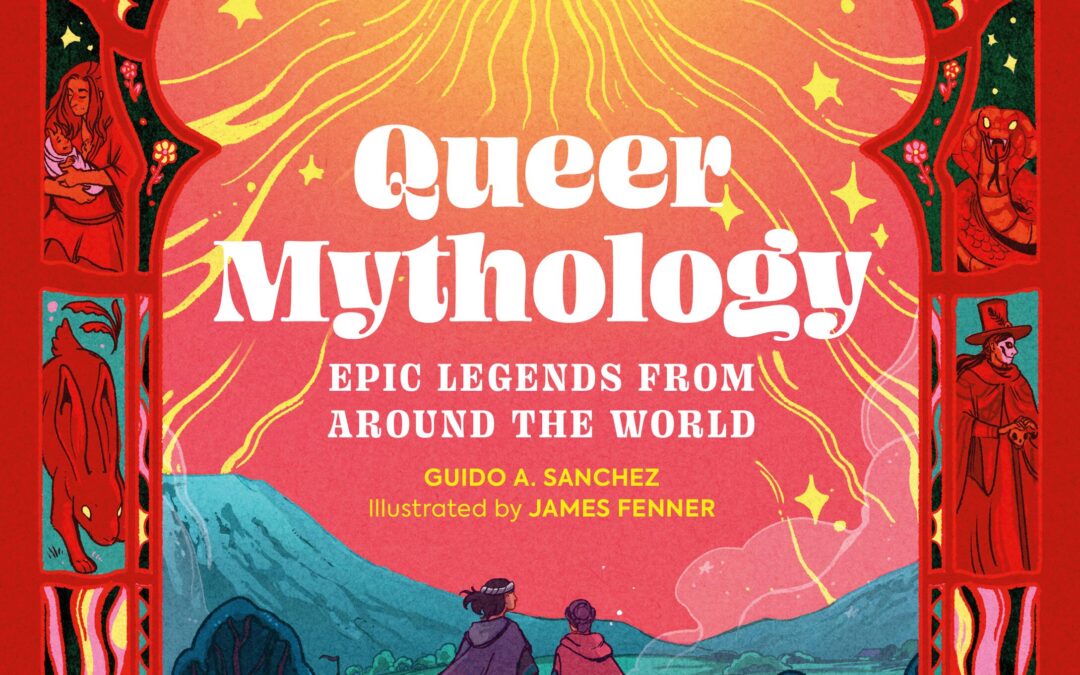
0 Comments